Document Number ENG-46158
Revision
Revision 1.8
Author
Yi-Chin Chu
Project Manager
JR Rivers
Serial-GMII Specification
The Serial Gigabit Media Independent Interface (SGMII) is designed to satisfy the following
requirements:
•
•
Convey network data and port speed between a 10/100/1000 PHY and a MAC with
significantly less signal pins than required for GMII.
Operate in both half and full duplex and at all port speeds.
Revision
Date
Description
1.8
1.7
1.6
1.5
1.4
1.3
1.2
1.1
1.0
April 27, 2005
July 20, 20001
Jan 4, 20001
Aug 4, 2000
June 30, 2000
April 17, 2000
Feb 8, 2000
Nov 10, 1999
Oct. 14, 1999
Add shim to the PHY transmit datapath to suppress TX_ER when TX_EN
is not asserted
Clarify data sampling and also the possible loss of the first byte of pream-
ble.
Added specifications for Cisco Systems Intellectual Property.
Specified the data pattern for the beginning of the frame (preamble, SFD)
for the frames sent from the PHY to make the PCS layer work properly.
Took out Jabber info, changed tx_Config_Reg[0] from 0 to 1 to make Auto-
Negotiation work
Increased allowable input and output common mode range. The output high
and low voltages were also increased appropriately. Added specification for
output over/undershoot. Added note about AC coupling and clock recovery.
Added timing budget analysis and reduced LVDS input threshold to +/- 50
mV.
Incoporated Auto-Negotiation Process for update of link status
Initial Release
MII – Media Independent Interface: A digital interface that provides a 4-bit wide datapath
between a 10/100 Mbit/s PHY and a MAC sublayer. Since MII is a subset of GMII, in this
document, we will use the term “GMII” to cover all of the specification regarding the MII
interface.
�
"
GMII – Gigabit Media Independent Interface: A digital interface that provides an 8-bit wide
datapath between a 1000 Mbit/s PHY and a MAC sublayer. It also supports the 4-bit wide MII
interface as defined in the IEEE 802.3z specification. In this document, the term “GMII”
covers all 10/100/1000 Mbit/s interface operations.
!
�
SGMII uses two data signals and two clock signals to convey frame data and link rate
information between a 10/100/1000 PHY and an Ethernet MAC. The data signals operate at
1.25 Gbaud and the clocks operate at 625 MHz (a DDR interface). Due to the speed of
operation, each of these signals is realized as a differential pair thus providing signal integrity
while minimizing system noise.
Figure 1 illustrates the simple connections in a system utilizing SGMII.
802.3z
Receive
PCS
S
y
n
c
h
8
0
2
3
z
.
802.3z Auto-Negotiation
802.3z
Transmit
PCS
RX
RXCLK
TX
TXCLK
CRS
RX_DV
RX_ER
RXD[7:0]
RX_CLK
COL
TX_EN
TX_ER
TXD[7:0]
TX_CLK
GTX_CLK
8
8
’
CRS
RX_DV
RX_ER
RXD[7:0]
RX_CK
COL
TX_EN
TX_ER
TXD[7:0]
TX_CLK
GTX_CLK
8
*
8
802.3z
Transmit
PCS
802.3z Auto-Negotiation
S
y
n
c
h
8
0
2
3
z
.
802.3z
Receive
PCS
* TX_ER Suppression
The transmit and receive data paths leverage the 1000BASE-SX PCS defined in the IEEE
802.3z specification (clause 36). The traditional GMII data signals (TXD/RXD), data valid
signals (TX_EN/RX_DV), and error signals (TX_ER/RX_ER) are encoded, serialized and
output with the appropriate DDR clocking. Thus it is a 1.25 Gbaud interface with a 625 MHz
clock. Carrier Sense (CRS) is derived/inferred from RX_DV, and collision (COL) is logically
derived in the MAC when RX_DV and TX_EN are simultaneously asserted. There is a small
block in the PHY transmit path to suppress TX_ER in full duplex mode when TX_EN is not
asserted.
Control information, as specified in Table 1, is transferred from the PHY to the MAC to signal
the change of the control information. This is achieved by using the Auto-Negotiation
functionality defined in Clause 37 of the IEEE Specification 802.3z. Instead of the ability
advertisement, the PHY sends the control information via its tx_config_Reg[15:0] as specified
in Table 1 whenever the control information changes. Upon receiving control information, the
MAC acknowledges the update of the control information by asserting bit 14 of its
tx_config_reg{15:0] as specified in Table 1.
SGMII details source synchronous clocking; however, specific implementations may desire to
recover clock from the data rather than use the supplied clock. This operation is allowed;
however, all sources of data must generate the appropriate clock regardless of how they clock
receive data.
#
$
%
&
(
�
"
The link_timer inside the Auto-Negotiation has been changed from 10 msec to 1.6 msec to
ensure a prompt update of the link status.
Bit Number
tx_config_Reg[15:0] sent from the PHY to the
MAC
tx_config_Reg[15:0] sent from
the MAC to the PHY
15
14
13
12
11:10
9:1
0
)
Link: 1 = link up, 0 = link down
0: Reserved for future use
Reserved for Auto-Negotiation acknowledge as
specified in 802.3z
1
0: Reserved for future use
0: Reserved for future use
Duplex mode: 1 = full duplex, 0 = half duplex
0: Reserved for future use
Speed: Bit 11, 10:
1 1 = Reserved
1 0 = 1000 Mbps: 1000BASE-TX, 1000BASE-X
0 1 = 100 Mbps: 100BASE-TX, 100BASE-FX
0 0 = 10 Mbps: 10BASET, 10BASE2, 10BASE5
0: Reserved for future use
0: Reserved for future use
0: Reserved for future use
1
’
!
1
/
Clearly, SGMII’s 1.25 Gbaud transfer rate is excessive for interfaces operating at 10 or 100
Mbps. When these situations occur, the interface “elongates” the frame by replicating each
frame byte 10 times for 100 Mbps and 100 types for 10 Mbps. This frame elongation takes
place “above” the 802.3z PCS layer, thus the start frame delimiter only appears once per frame.
The 802.3z PCS layer may remove the first byte of the “elongated” frame.
!
!
!
*
+
,
-
.
%
.
%
0
�
This section discusses how this SGMII interface shall be implemented by incorporating and
modifying the PCS layer of the IEEE Specification 802.3z.
Figure 2 shows the PHY functional block diagram. It illustrates how the PCS layer shall be
modified and incorporated at the PHY side in the SGMII interface.
CRS
RX
RXCLK
Seri-
alizer
ENC_RXD[0:9]
10
RX
RXCLK
PCS Transmit
State Machine
from 802.3z
Figure 36-5,
Figure 36-6
TX_EN
TX_ER
TXD[7:0]
TX_CLK
RX_DV
RX_ER
RXD[7:0]
RX_CLK @
125 MHz
PHY Receive
Rate Adaptation
GMII Signals from
10/100/1000PHY
RX_CLK @
2.5/25/125 MHz
Auto-Negotiation
Figure 37-6
Duplex
RX_DV
RX_ER
TX_ER
Half
Full
Full
x
0
1
x
x
x
RX_ER
0
RX_ER
TX
TXCLK
ENC_TXD[0:9]
Deseri-
alizer
10
Synchronization
Figure 36-9
PCS Receive
State Machine
from 802.3z
Figure 36-7
RX_DV
RX_ER
RXD[7:0]
RX_CLK
PHY Transmit
Rate Adaptation
GMII Signals to
10/100/1000PHY
TX_CLK @
2.5/25/125 MHz
TX_EN
TX_ER
TXD[7:0]
TX_CLK @
125 MHz
COL
$
5
,
At the receive side, GMII signals come in at 10/100/1000 Mbps clocked at 2.5/25/125 MHz.
The PHY passes these signals through the PHY Receive Rate Adaptation to output the 8-bit
data RXD[7:0] in 125MHz clock domain. RXD is sent to the PCS Transmit State Machine to
generate an encoded 10-bit segment ENC_RXD[0:9]. The PHY serializes ENC_RXD[0:9] to
create RX and sends it to the MAC at 1.25 Gbit/s data rate along with the 625 MHz DDR
RXCLK.
At the transmit side, the PHY deserializes TX to recover encoded ENC_TXD[0:9]. The PHY
passes ENC_TXD[0:9] through the PCS Receive State Machine to recover the GMII signals.
In the mean time, Synchronization block checks ENC_TXD[0:9] to determine the
synchronization status between links, and to realign if it detects the loss of synchronization.
1
’
2
3
4
$
%
&
2
3
4
&
�
"
The decoded GMII signals have to pass the PHY Transmit Rate Adaptation block to output
data segments according to the PHY port speed.
To make the PCS layer from 802.3z work properly, the PHY must provide a frame beginning
with at least two preamble symbols followed by a SFD symbol. To be more specific, at the
beginning of a frame, RXD[7:0] in Figure 2 shall be {8’h55, 8’h55, (8’h55.....), 8’hD5}
followed by valid frame data.
Some legacy end points have drop frames when RX_ER asserts during the first clock after a
frame ends. The Receive PCS state machine generates this signalling at the end of certain
frames. To avoid this problem, there is a small block in the PHY transmit path to surppress
TX_ER in full duplex mode when RX_DV (from the Receive PCS state machine) is not
asserted.
Figure 3 shows the MAC functional block diagram. It illustrates how the PCS layer shall be
modified and incorporated at the MAC side in the SGMII interface.
COL
CRS
AND
GMII Signals from
10/100/1000PHY MAC Receive
Rate Adaptation
Speed Information
RX_DV
RX_ER
RXD[7:0]
RX_CLK @
125 MHz
PCS Receive
State Machine
from 802.3z
Figure 36-7
RX_DV
RX_ER
RXD[7:0]
RX_CLK
ENC_RXD[0:9]
Synchronization
Figure 36-9
10
Deseri-
alizer
RX
RXCLK
Auto-Negotiation
Figure 37-6
GMII Signals to
10/100/1000PHY MAC Transmit
Rate Adaptation
Speed Information
TX_EN
TX_ER
TXD[7:0]
TX_CLK @
125 MHz
PCS Transmit
State Machine
from 802.3z
Figure 36-5
Figure 36-6
TX_EN
TX_ER
TXD[7:0]
TX_CLK
ENC_TXD[0:9]
10
Seri-
alizer
TX
TXCLK
#
$
5
,
At the receive side, the MAC deserializes RX to recover encoded ENC_RXD[0:9]. The MAC
passes ENC_RXD[0:9] through the PCS Receive State Machine to recover the GMII signals.
In the mean time, Synchronization block checks ENC_RXD[0:9] to determine the
synchronization status between links, and to realign once it detects the loss of synchronization.
!
2
3
4
1
’
$
%
&
1
’
&
�
The decoded GMII signals have to pass the MAC Receive Rate Adaptation block to output
data segments according to the PHY port speed, passed from the PHY to MAC via Auto-
Negotiation process.
At the transmit side, GMII signals come in at 10/100/1000 Mbps data clocked at 2.5/25/125
MHz. The MAC passes these signals through the MAC Transmit Rate Adaptation to output the
8-bit data TXD[7:0] in 125MHz clock domain. TXD is sent to the PCS Transmit State
Machine to generate an encoded 10-bit segment ENC_TXD[0:9]. The MAC serializes
ENC_TXD[0:9] to create TX and sends it to the PHY at 1.25 Gbit/s data rate along with the
625 MHz DDR TXCLK.
As described in Overview, it is necessary for the PHY to pass control information to the MAC
to notify the change of the link status. SGMII interface uses Auto-Negotiation block to pass the
control information via tx_config_Reg[15:0].
If the PHY detects the control information change, it starts its Auto-Negotiation process,
switching its Transmit block from “data” to “configuration” state and sending out the updated
control information via tx_config_Reg[15:0]. The Receive block in the MAC receives and
decodes control information, and starts the MAC’s Auto-Negotiation process. The Transmit
block in the MAC acknowledges the update of link status via tx_config_Reg[15:0] with bit 14
asserted, as specified in Table 1. Upon receiving the acknowledgement from the MAC, the
PHY completes the auto-negotiation process and returns to the normal data process.
As specified in Overview, inside the SGMII interface, the Auto-Negotiation link_timer has
been changed from 10 msec to 1.6 msec, ensuring a prompt update of the link status. The
expected latency for the update of link is 3.4 msec (two link_timer time + an acknowledgement
process).
!
Below we briefly describe at receive side how GMII signals get transferred across from the
PHY and recovered at the MAC by using the 8B/10B transmission code. The same method
applies to the transmit side.
According to the assertion and deassertion of RX_DV, the PHY encodes the Start_of_Packet
delimiter (SPD /S/) and the End_Of_Packet delimiter (EPD) to signal the beginning and end of
each packet. The MAC recovers RX_DV signal by detecting these two delimiters.
The PHY encodes the Error_Propagation(/V/) ordered_set to indicate a data transmission error.
The MAC asserts RX_ER signal whenever it detects this ordered_set.
CRS is not directly encoded and passed to the MAC. To regenerate CRS, the MAC shall uses
signal RX_DV before it is being passed to the MAC Receive Rate Adaptation block as shown
in Figure 3.
The MAC decodes ENC_RXD[0:9] to recover RXD[7:0].
Figure 4 illustrates how the MAC samples data in 100 Mbit/s mode. As signals shown in
Figure 2, the GMII data in 100 Mbit/s mode get replicated ten times after passing through the
PHY Receive Rate Adaptation to generate RXD[7:0]. The modified PCS Transmit State
Machine encodes RXD[7:0] to create ENC_RXD[0:9]. As noted in the Overview, the SPD(/S/
) only appears once per frame. SAMPLE_EN is a MAC internal signal to enable the MAC
sampling of data starting at the first data segment (/S/) once every ten data segments in 100
Mbit/s mode.
6
�
"
A note to Figure 4: there is no fixed boundary for the data sampling. Also the first byte of
preamble might be only repeated 9/99 instead of 10/100 times due to the algorithm of the
802.3z PCS Transmit State Machine.
125 MHz Clock
RX_DV
Data in 100 Mbit/s
Domain
RXD[7:0] after
Rate Adaptation
ENC_RXD[0:9]
SAMPLE_EN
Data0
Data1
Data2
D0 D0 D0 D0 D0 D0 D0 D0 D0 D0 D1 D1 D1 D1 D1 D1 D1 D1 D1 D1 D2 D2 D2 D2 D2 D2 D2 D2 D2
/S/
d0
d0
d0
d0
d0
d0
d0
d0
d0
d1
d1
d1
d1
d1
d1
d1
d1
d1
d1
d2
d2
d2
d2
d2
d2
d2
d2
d2
! *
The basis of the LVDS and termination scheme can be found in IEEE1596.3-1996. Some
parameters have been modified to accommodate the 1.25Gb/s requirements. SGMII consists of
the most lenient DC parameters between the general purpose and reduced range LVDS.
Both the data and clock signals are DC balanced; therefore, implementations that meet the AC
parameters but fail to meet the DC parameters may be AC coupled.
!
$
%
&
)
%
7
�



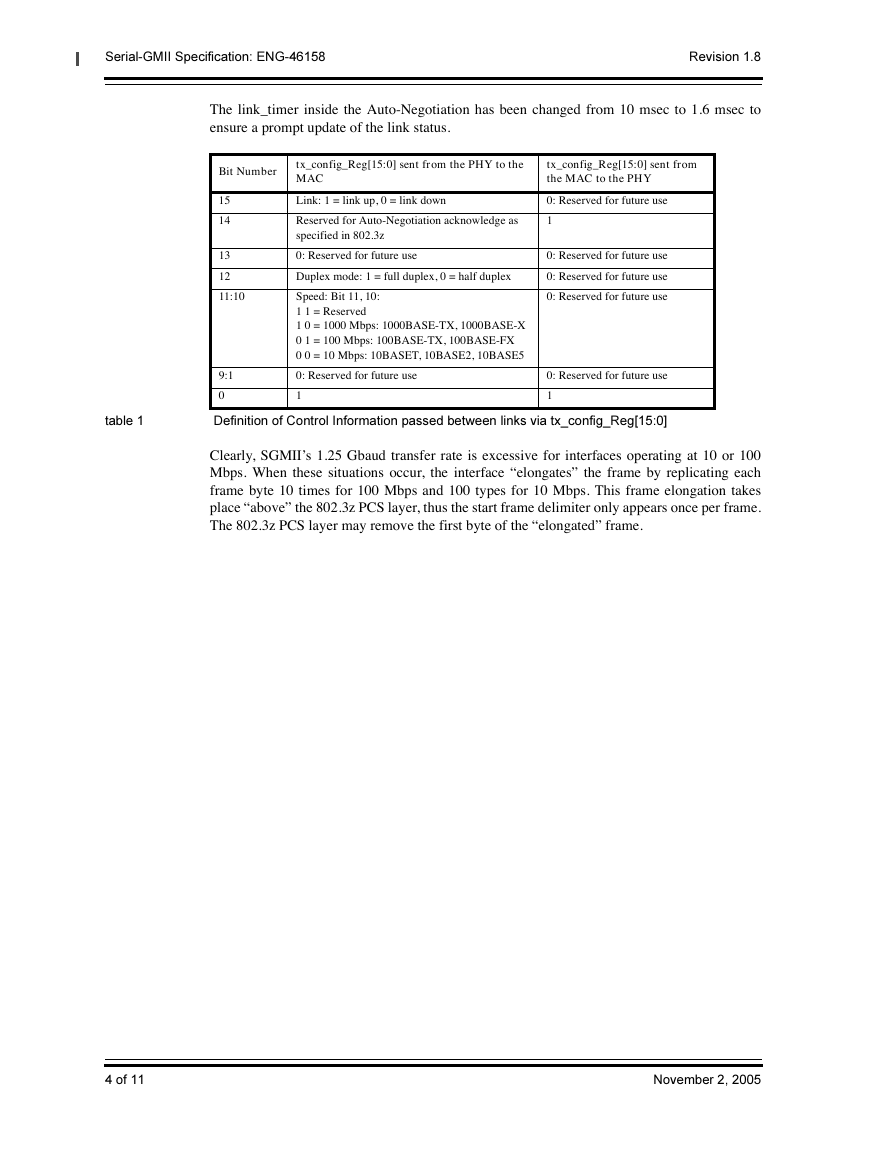
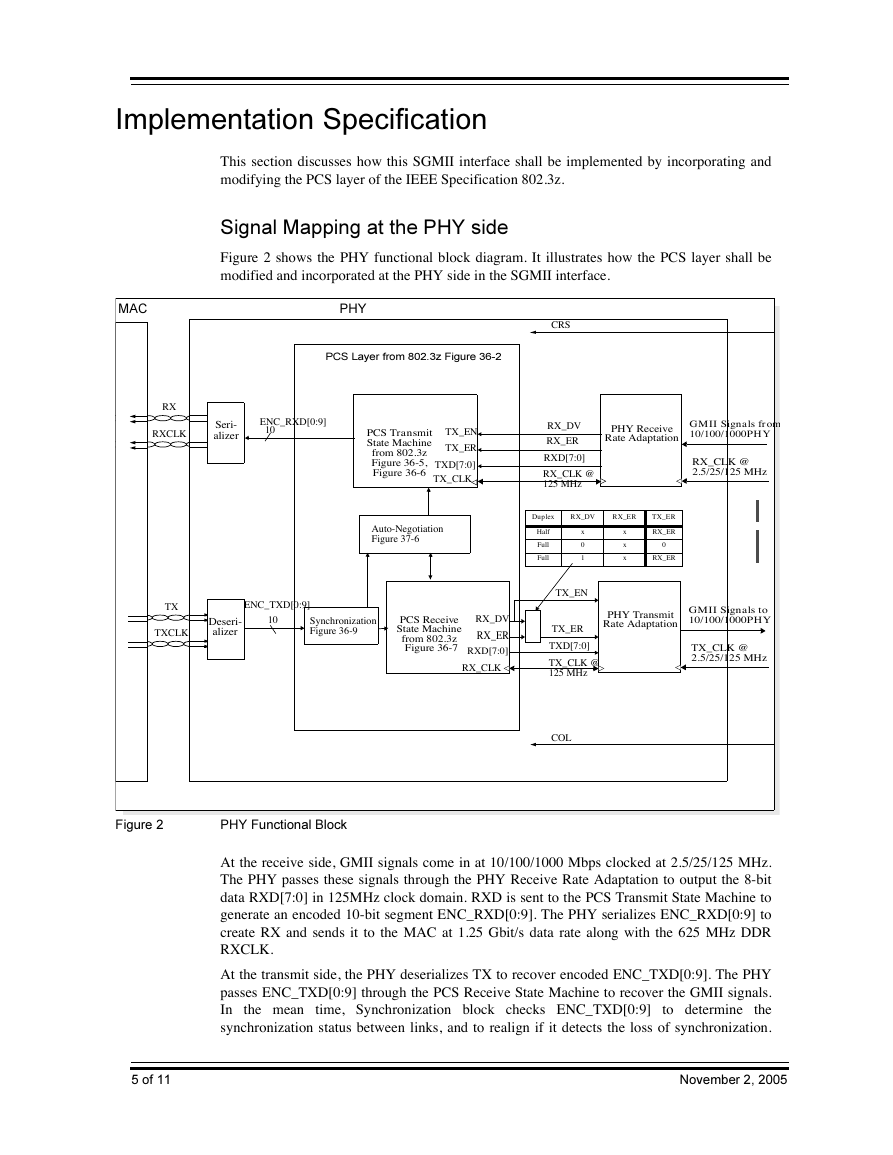
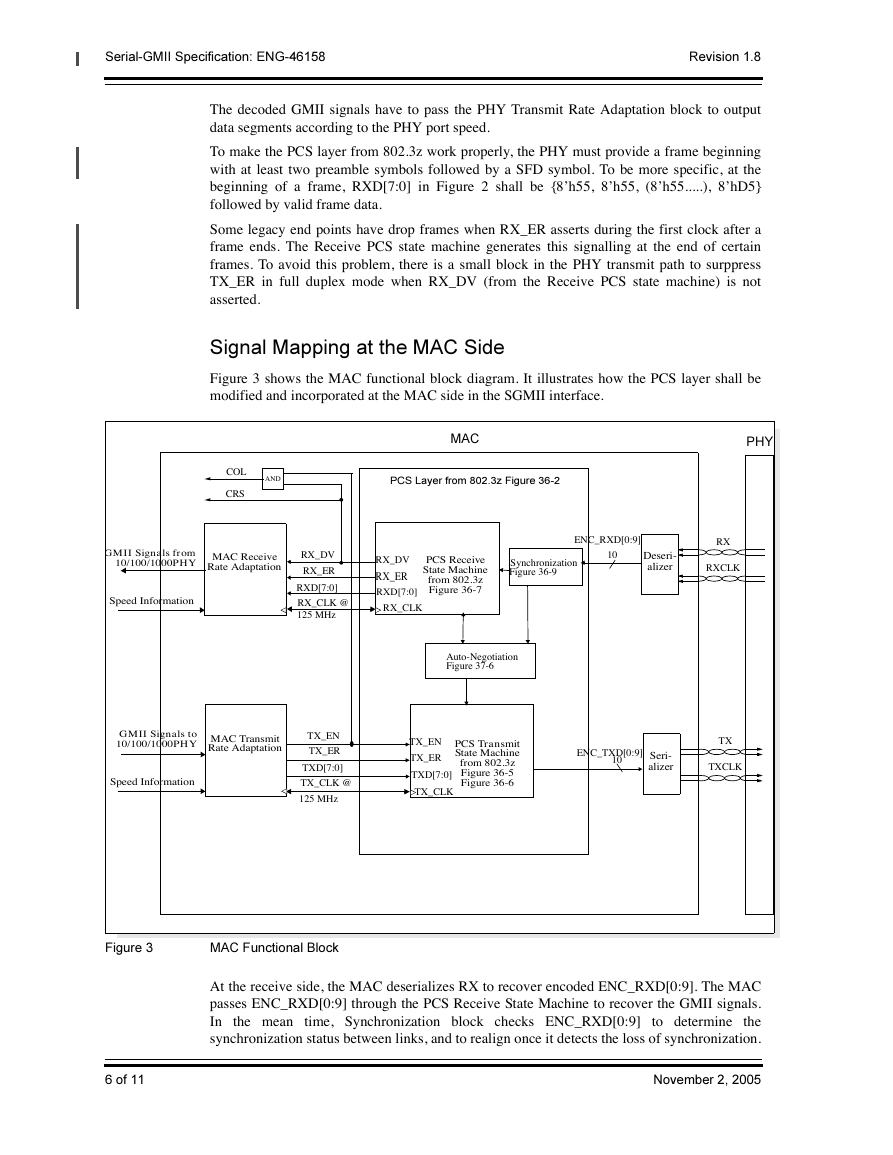
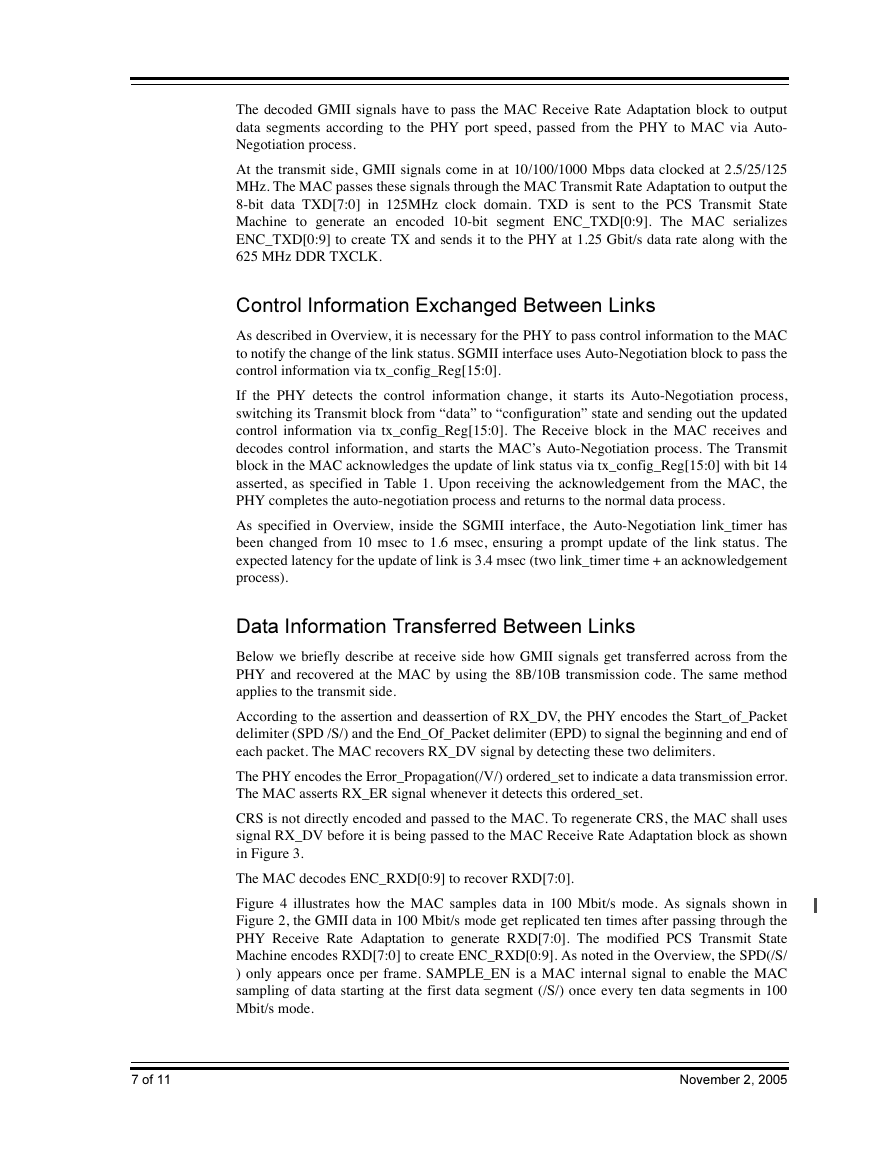
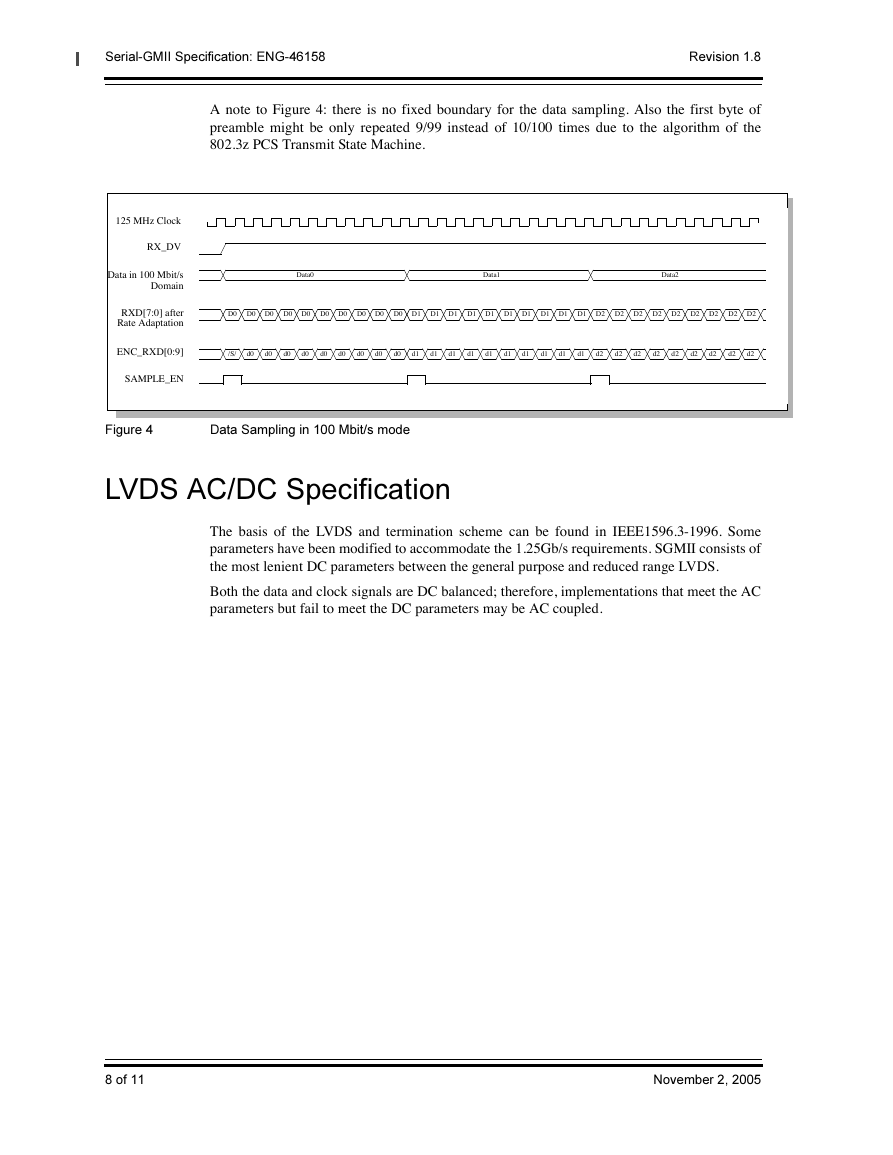








 2023年江西萍乡中考道德与法治真题及答案.doc
2023年江西萍乡中考道德与法治真题及答案.doc 2012年重庆南川中考生物真题及答案.doc
2012年重庆南川中考生物真题及答案.doc 2013年江西师范大学地理学综合及文艺理论基础考研真题.doc
2013年江西师范大学地理学综合及文艺理论基础考研真题.doc 2020年四川甘孜小升初语文真题及答案I卷.doc
2020年四川甘孜小升初语文真题及答案I卷.doc 2020年注册岩土工程师专业基础考试真题及答案.doc
2020年注册岩土工程师专业基础考试真题及答案.doc 2023-2024学年福建省厦门市九年级上学期数学月考试题及答案.doc
2023-2024学年福建省厦门市九年级上学期数学月考试题及答案.doc 2021-2022学年辽宁省沈阳市大东区九年级上学期语文期末试题及答案.doc
2021-2022学年辽宁省沈阳市大东区九年级上学期语文期末试题及答案.doc 2022-2023学年北京东城区初三第一学期物理期末试卷及答案.doc
2022-2023学年北京东城区初三第一学期物理期末试卷及答案.doc 2018上半年江西教师资格初中地理学科知识与教学能力真题及答案.doc
2018上半年江西教师资格初中地理学科知识与教学能力真题及答案.doc 2012年河北国家公务员申论考试真题及答案-省级.doc
2012年河北国家公务员申论考试真题及答案-省级.doc 2020-2021学年江苏省扬州市江都区邵樊片九年级上学期数学第一次质量检测试题及答案.doc
2020-2021学年江苏省扬州市江都区邵樊片九年级上学期数学第一次质量检测试题及答案.doc 2022下半年黑龙江教师资格证中学综合素质真题及答案.doc
2022下半年黑龙江教师资格证中学综合素质真题及答案.doc